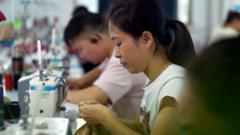In the bustling district of Panyu, Guangzhou, the relentless sound of sewing machines fills the air, producing clothing for fast fashion giant Shein, a company that has exploded onto the global retail scene. Despite its success, concerns surrounding labor practices and worker rights have emerged, shedding light on the human cost behind alluringly cheap clothing prices.
Workers in the so-called “Shein village” often endure grueling hours, clocking around 75 hours a week—an infringement of local labor laws that dictate a maximum of 44 hours weekly and require at least one day off. Many laborers report only having one day off a month, illustrating the high-pressure environment in which this industry operates.
The BBC's investigation revealed a stark reality for many of these workers, who come from rural areas seeking better wages. The low pay, often calculated per piece, leaves them struggling to cover living expenses, as they earn between low yuan per item, leading to monthly incomes anywhere from 4,000 to 10,000 yuan—well below the actual living wage required in China.
Shein, valued at an estimated $66 billion, has gained significant traction due to its vast inventory and aggressive pricing, with products frequently under $8. This competitive edge has raised questions about the sustainability and ethics of its labor practices, especially considering the allegations of forced labor among the Uyghur population in Xinjiang.
While the company claims to be improving working conditions through governance investments and by enforcing compliance with certain standards, many say more transparency is crucial. They argue that the company must release detailed information about its supply chain to reassure consumers and investors amidst growing scrutiny.
Critics, including rights organizations and political figures, emphasize the need for Shein to address these ethical concerns to maintain credibility and ensure fair treatment of its workers. As the company eyes an IPO on the London Stock Exchange, the pressure to present a positive corporate image has intensified.
For factory owners, the requirements set by Shein have led to tighter profit margins, with the company exerting significant control over pricing. Many owners express a complicated relationship with the fast-fashion retailer, thankful for the business it brings but weary of the constraints it imposes, particularly regarding labor costs.
While the booming factory scene in Panyu continues to churn out millions of garments daily, the workers' narratives reveal an intricate blend of hardship and pride in contributing to a global economy. They find solace in camaraderie and community among their fellow laborers, even as they navigate the challenges of demanding workloads and meager earnings.
The complex fabric of labor in Shein's supply chain not only highlights the depths of modern retail exploitation but also calls into question the wider implications of fast fashion trends in a rapidly changing global market. As consumers around the world shop for the next bargain, the reality of the hands that make those garments remains a critical issue in the discourse surrounding ethical fashion and consumer responsibility.
Workers in the so-called “Shein village” often endure grueling hours, clocking around 75 hours a week—an infringement of local labor laws that dictate a maximum of 44 hours weekly and require at least one day off. Many laborers report only having one day off a month, illustrating the high-pressure environment in which this industry operates.
The BBC's investigation revealed a stark reality for many of these workers, who come from rural areas seeking better wages. The low pay, often calculated per piece, leaves them struggling to cover living expenses, as they earn between low yuan per item, leading to monthly incomes anywhere from 4,000 to 10,000 yuan—well below the actual living wage required in China.
Shein, valued at an estimated $66 billion, has gained significant traction due to its vast inventory and aggressive pricing, with products frequently under $8. This competitive edge has raised questions about the sustainability and ethics of its labor practices, especially considering the allegations of forced labor among the Uyghur population in Xinjiang.
While the company claims to be improving working conditions through governance investments and by enforcing compliance with certain standards, many say more transparency is crucial. They argue that the company must release detailed information about its supply chain to reassure consumers and investors amidst growing scrutiny.
Critics, including rights organizations and political figures, emphasize the need for Shein to address these ethical concerns to maintain credibility and ensure fair treatment of its workers. As the company eyes an IPO on the London Stock Exchange, the pressure to present a positive corporate image has intensified.
For factory owners, the requirements set by Shein have led to tighter profit margins, with the company exerting significant control over pricing. Many owners express a complicated relationship with the fast-fashion retailer, thankful for the business it brings but weary of the constraints it imposes, particularly regarding labor costs.
While the booming factory scene in Panyu continues to churn out millions of garments daily, the workers' narratives reveal an intricate blend of hardship and pride in contributing to a global economy. They find solace in camaraderie and community among their fellow laborers, even as they navigate the challenges of demanding workloads and meager earnings.
The complex fabric of labor in Shein's supply chain not only highlights the depths of modern retail exploitation but also calls into question the wider implications of fast fashion trends in a rapidly changing global market. As consumers around the world shop for the next bargain, the reality of the hands that make those garments remains a critical issue in the discourse surrounding ethical fashion and consumer responsibility.


















